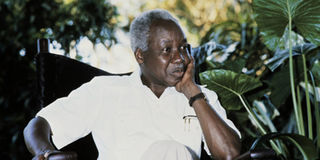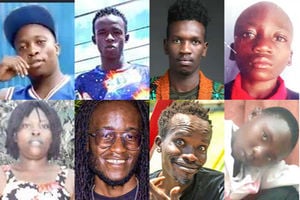Of Nyerere, ‘Juliasi Kaizari’ and the Tanzanian literature

Tanzanian President Julius Nyerere is pictured, on January 31, 1985, in Dar es Salam, Tanzania. Mwalimu Julius Nyerere’s emergence as a literary figure, with his Juliasi Kaizari and Mabepari wa Venisi, can be traced back to his Makerere College days in the latter half of the 1940s. PHOTO | FILE | NATION MEDIA GROUP
What you need to know:
- I have no evidence that Nyerere was in the cast or crew. In the nearly 10 years I worked with Macpherson I don’t remember her mentioning Mwalimu’s participation
Of particular literary and linguistic interest, however, is Mwalimu’s decision to launch his literary career with Shakespeare in Kiswahili
Mwalimu knew, however, that the future of Tanzania’s culture lay in Kiswahili. To share Shakespeare with his people, he had to deliver him in Kiswahili, hence his daring translation enterprise
Mwalimu Julius Nyerere’s emergence as a literary figure, with his Juliasi Kaizari and Mabepari wa Venisi, can be traced back to his Makerere College days in the latter half of the 1940s.
I was a mere toddler then, but as I grew up I got to hear of the legendary production of Shakespeare’s Julius Caesar, in which our equally legendary teacher, Margaret Macpherson, directed a cast comprising an array of future East African leaders, including Apollo Milton Obote.
I have no evidence that Nyerere was in the cast or crew. In the nearly 10 years I worked with Macpherson I don’t remember her mentioning Mwalimu’s participation.
What is certain, however, is that as an English language student of hers at Makerere, Nyerere would have been widely exposed to classical English Literature, including Shakespeare.
Of particular literary and linguistic interest, however, is Mwalimu’s decision to launch his literary career with Shakespeare in Kiswahili. It points to a number of significant developments in his and Tanzania’s literary journey.
TRANSLATION
Apparently, Mwalimu liked and valued the positive elements in his cosmopolitan education. He might have fought the British colonists, but he wasn’t going to throw his Shakespeare “baby” out with the colonial bathwater.
Mwalimu knew, however, that the future of Tanzania’s culture lay in Kiswahili. To share Shakespeare with his people, he had to deliver him in Kiswahili, hence his daring translation enterprise.
I call it daring because translation is such a complex affair that some purists even claim that it is impossible to properly translate any text at all.
Yet experience tells us that translation is a necessary channel of communication wherever two or more languages meet. How many people have ever read the Bible in its original tongues?
But that doesn’t mean that Mwalimu’s task of taking the English bull by the horns (or is it sharp spears?) and dragging it into the Kiswahili zizi was an easy feat by any means.
He probably took it on because he saw the great teaching value in the bard’s texts. Julius Caesar, for example, is an engaging study in the quest for political power, while The Merchant of Venice is a startling revelation of the evils of rapacious money-dominated systems.
Apart from the relevant content, Mwalimu’s translations were practical demonstrations of the versatility and sophistication of Kiswahili, and its capability to take on the subtlest nuances of dramatic poetry.
PUBLISHING LANGUAGES
Anyway, his work across the two transnational languages in which he was equally fluent points to a significant trend in Tanzanian creative writing, which we may tend to ignore today.
Most East Africans assume that Tanzania’s creative writers publish almost exclusively in Kiswahili.
This is not accurate. Tanzanian authors, especially those of my generation, were as likely to write in English as in Kiswahili.
Thus you get quality prose texts like Peter Palangyo’s Dying in the Sun, Gabriel Ruhumbika’s Village in Uhuru, and the fairly recent Elieshi Lema’s Parched Earth – a Love Story.
Nor should we forget that the current international giants, Abdulrazak Gurzah and Moez Vassanji, are Tanzanians.
I haven’t met Gurzah face to face, but Vassanji is a friend. He even once gave me his well-padded anorak when I was shivering in the chill of a Toronto winter in the early 1990s.
Only, the Tanzanians never seem to lose sight of their Kiswahili home. A good example of this is the early work of my undergraduate contemporary, Ibrahim Hussein. His Kinjeketile Kiswahili and English texts were published almost simultaneously.
The Tanzanians also maintain Mwalimu’s conviction that the best of world literature should be brought home, through quality translation, to their Kiswahili reading compatriots.
Hence the appearance of texts like Masaibu ya Ndugu Jero, Shamba la Wanyama, Mkaguzi Mkuu wa Serikali and Mfalme Edipode, which we read today as Kiswahili texts in their own right.
This, however, is not to minimise the singular impact of our colleagues working primarily in Kiswahili. Of my classmate Euphrase Kezilahabi, probably the subtlest artist working in the language today, I can say very little, because he always said, and still says, very little himself.
Kezilahabi lets his creative pen say it all for him. It was his verse that concretised the mashairi huru revolution that liberated Kiswahili verse from the “shackles” of traditionist conventions.
This way, that way . . .
DEBATE NOT OVER
The debate between the wanamapokeo conservatives and the experimentalists, led by Kezilahabi and vigorously defended by his younger siblings, like Kahigi and Mulokozi, the wachokozi wa Kilimani (provocateurs of University Hill), may not even be over yet.
But, as our own learned professors, Kimani Njogu and Kithaka wa Mberia, have variously observed, the liberalisation is irreversible.
My most beloved Tanzanian scribe, however, is the prolific, multi-talented Pemban, Said Ahmed Mohamed (Khamis). We first met on the Ubungo campus in the early 2000s, at an Institute of Kiswahili Research (TUKI) conference.
But, like many other lovers of Kiswahili Literature, I was already an enthusiastic convert to his work, starting with his anti-racist, anti-colonial and anti-sexist first novel, Asali Chungu.
Poet, novelist, dramatist, children’s writer and accomplished academic, Mohamed is the quintessence of an all-round man of letters.
PRODUCTIVE AUTHOR
But there’s lots more to this uniquely energetic and consistently productive author, as I happily found out when I worked closely with him during my brief stint as a Visiting Professor at the Bayreuth University’s Institute of African Studies in Germany in 2009.
Mohamed’s profound humility and his irresistible exuberance and friendliness can easily make you forget that you are in the presence of greatness when you meet him.
His constant greeting whenever we met was “Siha (how’s your health)?” And he always delivered it with such lively vigour that I would find myself coming up with a strong “thabiti (great)!” even when I wasn’t feeling so top of the world. His is what I would call a healing greeting.
I hope I will be able to reflect Mohamed’s genuine human concern in my planned Hazina ya Said Ahmed Mohamed, based on our conversations in Bayreuth.





